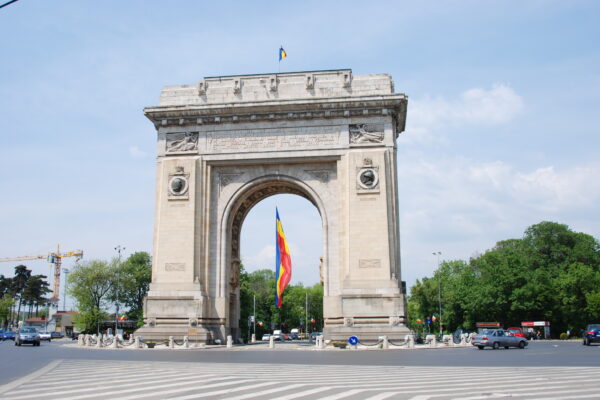This article originally appeared on The German Marshall Fund of the United States website, from Brie Loskota’s experience with The Marshall Memorial Fellowship (MMF).
I have always pictured Central and Eastern Europe in black and white. More precisely, in various shades of gray. Dark gray, silvery gray, whitish gray but always gray. Life there, I imagined, was flat, colorless and uninspired. This image was so vivid in my mind that I never considered that it might be inaccurate. I should have known better. I have visited nearly 40 countries in my 38 years, but this image had staying power. I never interrogated it enough to even think about regional differences, country distinctions or anything else that might complicate my naïve view of this part of the world.
This was a perspective that I formed as a child of the Cold War. My earliest memories involve the Soviet Union, Ronald Reagan and an impending sense of doom. When I was three years old I climbed into my dad’s lap and asked him if I could pray hard enough to stop nuclear war. He says he does not remember his answer, but it must have satisfied me, though only in that moment. The threat of doomsday still loomed in my mind.
When the Berlin Wall fell I remember feeling as much a sense of relief for myself as for the people living behind it. Scorpions’ “Winds of Change” still brings me near tears. To this day I regret not buying a piece of the Berlin Wall from one of those TV infomercials, though they were probably hawking fake goods. Still, it would not have mattered to me if my chunk of the Berlin Wall was fake because I was buying a dream of a new world that had rejected authoritarianism for the promise of democracy.
But even after East Germany and the rest of Eastern Europe emerged from behind the Iron Curtain, the region never came into focus for me. It was still grey, still bleak in my imagination. Life there remained a frozen Cold War tableau: still uninspired, still distant, and still strange.
Several years ago a friend returned from Warsaw and told me, “Warsaw is in color.” She had shared my view of that part of the world as relentlessly gray, but her visit shattered those perceptions. “Sure it is,” I thought, nodding as if I understood and as if my friend’s report was enough to broaden the palate that I was using to paint this place in my imagination.
Then I landed in Bucharest during my Marshall Memorial Fellowship. I said that I had no expectations, but that was a lie. It did not take more than a few hours to fill in a richer picture of this place. The gray was replaced with green – broad avenues lined with leafy trees and open park-like spaces. French-inspired architecture pointed to a cosmopolitan society that had flourished before the veil of Communism and the ugliness of Soviet-era apartment blocks. And the people were not dull or lifeless. They seemed like they had found a U.S. government-created propaganda piece on the American values of hard work, excellence, and individualism, and decided it was a roadmap for how to build a post-authoritarian culture.
Just as my picture of Bucharest began to be colored, it was America that started to look gray. The Trump administration had pushed through a health care bill that cared little about health and the cost of which would be paid by the poorest and most vulnerable Americans.
Yet when Americans complain about government dysfunction, foreign policy gone off the rails or rising populism, my new Romanian friends respond with a knowing chuckle, hard-earned from decades of repression. Romanian society longs for the kind of “dysfunction” we have had.
Nothing animates the Romanian political class I spoke with like the topic of Russia. It is a personal insult extrapolated to a national scale that Americans refuse the counsel of places like Romania that know what darkness Russian meddling can bring. While Trump dismisses NATO as a costly artifact of a bygone era that is now of little use the United States, Romanians cling to the enforceability of Article 5 of the Washington Treaty to secure not only their borders but also their futures. As our dysfunction slides us closer to Putin-style authoritarianism, the knowing laughter turns to anger, as the promise of our American experiment seems to slip away.
As one person said over one of our MMF dinners in Bucharest, “We used to look to America as a light, but now we have no lighthouse.”
When I boarded a plane to leave Romania, news broke that Trump had fired FBI Director James Comey, which commentators immediately tied to the ongoing Russian-Trump entanglement and investigations.
The United States once stood for freedom, democracy, and opportunity, even if those values represented an aspiration as much as a reality. That light has dimmed alarmingly. As we stumble further down into the kind of darkness that Romanians are now climbing out of, my trip serves as a cautionary tale that the color and vibrancy of a society can fade more quickly than it brightens.
While I have not given up on the United States, without our beacon the rest of the world has begun to turn perhaps reluctantly toward France and more optimistically toward Germany to light the way, leaving us in a darkness of our own making. My hope is that we emerge from it more quickly than the 40 years it took Romania to recover its bout with repression.
Photo Credit: George M. Groutas / Flickr
Brie Loskota is the former executive director (2016-2021) of the USC Center for Religion and Civil Culture.


